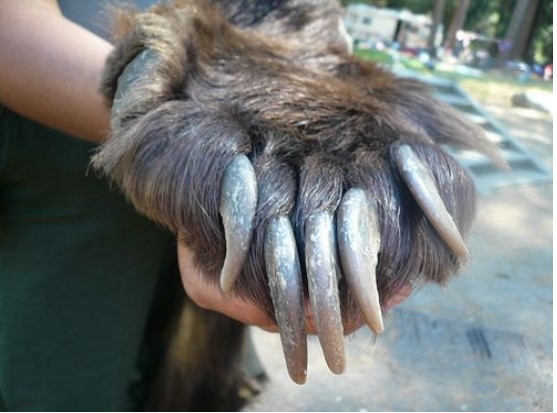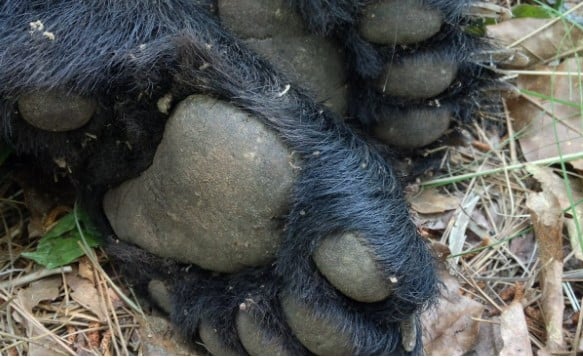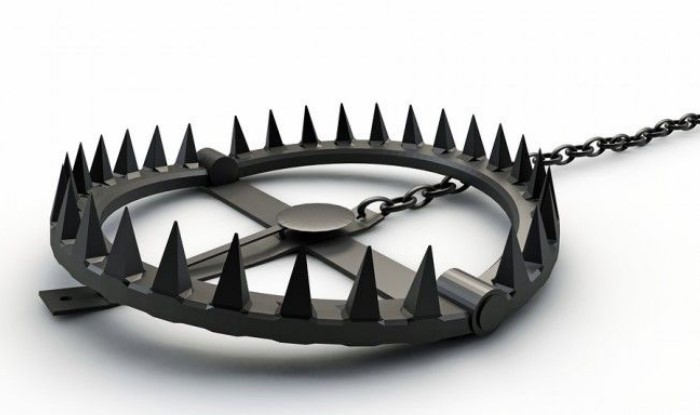The Mysterious Case Of Brown Grizzly Bears With Missing Toes
With so many strange and interesting happenings around the world, bears mysteriously missing toes would seem unlikely. Firstly, depending on the location, a bear sighting is a rare occurrence and will be a memory to cherish. But seeing a bear with missing toes – now that’s worth spiking anyone’s interest and curiosity.
Surely, one wouldn’t blame the Canadian Wildlife Biologist – Clayton Lamb – who went on a half-decade quest to solve the mystery of grizzly bears found with missing toes.
Brown Grizzly Bears
Don’t be surprised to encounter a brown grizzly bear when hiking in the woods. These fur-filled animals, living in the forest and mountainous regions, are strong and intimidating.

Source: Gohunt/Pinterest
Standing as tall as 2.5 m (8 ft) and weighing up to 360 kg (800 lbs.), with curved claws as sharp as a double-edged sword, these stout bears spend their time alone roaming their habitat and searching for food.
The Rough Lives of Grizzlies
Grizzly bears once lived plentifully across western North America, even as far south as Mexico. Sadly, they lost their habitat when European settlements and aggressive hunting eliminated most of the population.

Source: orilovesLVJY/ Twitter
The invasion of humans sent these grizzlies away from what used to be home to higher grounds like the Northern Rocky Mountains and other remote areas of the Northwest. They can still be found in parts of Wyoming, Montana, Idaho, and Washington State.
The Sharp Claws of a Grizzly Bear
The distinctive features of grizzly bears are their strong, powerful shoulder hump and very large claws. Grizzly bears have 20 digits. Their front claws are curved, sturdy, and large, measuring at least 2-4 inches (5-10cm) long.

Source: Claytontlamb/Twitter
Driven by their powerful forelimbs, they use their claws for digging roots, lifting rocks to find insects, grounding squirrels, and excavating winter dens. They simply cannot eat or hibernate without their paws. Their proud shoulder hump and paws differentiate them from black bears.
Wildlife Research
The size, power, and intelligence of grizzlies intrigue biologists, scientists, and conservationists. The pursuit to know more about their wildlife, personality traits, behavior, and habitat quality has driven these experts to conduct scientific research on them.

Source: Fancy Scientist/YouTube
The result of their scientific research helps them know the role these bears hold in particular ecosystems. They also help provide information to the public, decision-makers, the scientific community, and students.
The Canadian Biologist at the Ski Resort
Sometime in 2016, it was just another day for exploration for wildlife scientist Clayton Lamb at Fernia, a ski resort in the mountains of British Columbia. The wildlife scientist was trapping grizzly bears for a research project to understand their survival and movement in southeast British Columbia.

Source: Wild49Eco/Twitter
He was moving a sleeping bear with conservation officers at the resort. The team of experts had tranquilized the animal with a GPS collar to haul it when Lamb noticed a piece of its paw was missing.
Missing Bear Toes – A Red Flag?
Like any fight for dominance or survival, grizzly bears are not immune. They can become defensive and dangerous when provoked or threatened, and their fights can result in grievous injuries or death. With their sheer size and sharp claws, an opponent who goes against a grizzly is unlikely to walk away without getting hurt.

Source: Rebeccamprater/Twitter
Perhaps this is why Lamb was unfazed when he noticed the missing toe. “Grizzlies lead rough lives, brawling and biting one another. So the missing toe of one bear wasn’t necessarily a red flag for us,” Lamb said.
Not an Injury Afterall
Admittedly, these huge solitary animals can get injured in a fight for dominance, food, or territory. However, Lamb was perplexed when he encountered another bear with missing toes. While doing his fieldwork for his Ph.D., at the University of Alberta, four bears popped up in the province’s Elk valley region sporting similarly mangled paws.

Source: MikeDoris/Twitter
Weirdly, the pattern was unmistakable, and this discovery piqued the scientist’s interest. He was anxious to solve the mystery behind this shocking trend.
The Half-Decade Quest for Answers
Lamb and his colleagues launched a half-decade investigation to unravel the mystery behind the grizzly trend. At first, they wondered if grizzlies were born without paws, and they discussed this assumption with wildlife veterinarians. But, they ruled out birth defects or exposure to some type of toxin as the cause.

Source: ClaytonTLamb/Twitter
Next, they had one of the feet x-rayed, and the x-ray images showed bone fragments. Surely, this was a sign of an injury that had healed.
A Sign of Human Cause
Apparently, the fractures detected from the x-ray were too straight for the toes to be mauled by an animal. S0 something must have torn off the paws of these bears, and Lamb was determined to find the “what.”

Source: HebblewhiteLab/Twitter
Their findings suggested a human cause. The team discussed the issue with trappers and hunters, and they considered that these bears were getting their feet caught on mouse traps often set for weasels, martens, and other furbearers.
A Trap of Our Own
Lamb and his team were determined to get evidence to establish that the baited traps were the potential culprit. To this end, Lamb set up an experiment by installing motion-sensor cameras near four traps that were tweaked to remain open, to prevent snapping any toes of the grizzlies.

Source: myfamilysurvivalplan/Pinterest
The trap wasn’t intended to hurt any bears but to see whether the inquisitive nature of the bears led to these unusual injuries.
The Experimental Result of the Bait Traps
Two weeks later, the camera footage showed bears sticking their paws and noses on the traps. All four traps were visited by grizzly bears, tripping two of them. Bewildered, Lamb wondered if a trap meant for tiny creatures would hurt an animal as big as a grizzly.

Source: Caters Clip/ Youtube
To test the theory, the team hooked a dead bear’s paw to a trap attached to his pickup truck to see how much force it would require to break a toe. “I did a number of things that I never thought I was going to do as a scientist,” Lamb said.
A Slow Painful Experience
From the test, the team discovered that traps weren’t strong enough to rip off a bear’s toes instantly. Instead, the trapping device would cut off blood circulation in the toe, causing the tissues to die. Eventually, the toes would rot away after several painful weeks/months or be gnawed by the bears.

Source: Pinterest
Sadly, these grizzly bears go on with their daily lives writhing from the soreness and could have challenges digging for food and protecting themselves.
A Cause for Concern
Certainly, these traps could cause problems for the bears. Accidentally amputated toes could have consequences for the area’s human population too. However, they weren’t that serious an issue to cause population decline.

Source: ClaytonTLamb/Twitter
“I’m most concerned about the overall welfare of those individual bears,” Lamb said. “It’s not a population concern, but it’s still a concern. I think causing that level of suffering is not something that aligns with most of our land ethics.”
The Consequence of Amputated Toes
Certainly, these injuries affect human-bear coexistence, too. Injured bears without the full use of their paws to dig for food become more aggressive in pursuit of their meal. For that reason, they can be dangerous.

Source: iStock Photo
Three of the four bears with missing toes were later involved in human-bear conflicts. One was fatally shot by a rancher, and another was suspected of attacking a human. The third was captured and relocated by conservation officers after causing a ruckus on a farm.
The Quest for Solutions
In the bid to proffer solutions to this problem, some suggested that the traps be anchored so that bears could pull out their toes instead of carrying away the traps. However, Lamb and his team tested this theory by placing a dead grizzly’s leg into a better-anchored trap. They found it wasn’t always easy to pull the leg out.

Source: Wildsight/Twitter
Additionally, hunters and trappers were likely to come in contact with bears trying to wriggle free from a trap, which isn’t safe.
A Call to Ban Trapping
Another suggestion was to ban the fall trapping season by two weeks until the end of November and the beginning of December. As this was the period when grizzlies are still active. However, some tappers and those in the fur business pushed back on the idea.

Source: ClaytonTLamb/Twitter
For one, delaying trapping until deep winter would increase the risk of avalanches in bear country. Also, small mammal trapping is generally done in the early winter when fur is prime and most valuable.
Ideas to Create Innovative Traps
Lamb also suggested a different trap with a smaller, constricted entrance so most bear paws could not fit inside to grab the bait. The opening would be big enough for a marten to squeeze through but too small for a grizzly’s foot.

Source: MJLPeers/Twitter
With this, Lamb recognizes that shifting the trapping season and innovating a new system will impact the trappers’ livelihood. It will also require compliance monitoring, adding more responsibilities to conservation officers.
The British Columbia Wildlife Officials
Based on these investigations and guidance from this brilliant wildlife scientist and colleagues, in 2021, the southeast British Columbia wildlife officials started requiring that all body-gripping traps deployed in November must be enclosed inside a box with an opening large enough for a marten to wriggle through. But, it had to be small enough to admit a bear paw.

Source: Edward Smith/Pinterest
This was a condition for trapping licenses. “It’s the ethical thing to do,” said Tim Killey, a trapper who leads the British Columbia Trappers Association.
Compliance With the Rules
While the rules have already been enforced to reduce trap entrances in November, people still flout the rules. “The main goal here is to keep bear toes out of traps,” Lamb said. “If we could find a solution to keep trappers trapping and bear toes safe, that’s great.”

Source: Wikipedia Commons
He had recommended delaying the marten trapping season until December 1, 2021, after most grizzlies will have gone into hibernation, but these changes have not been implemented.
What Next?
Thanks to the recently published research in the scientific publication Wildlife Society, the issue with accidental amputation of grizzly bear toes have identified, and there is an urge for immediate action to be taken.

Source: Claytontlamb/Twitter
“The solutions we present have various pros and cons, and we hope this work can help policy-makers choose a solution that will resolve the amputated toe issue while ensuring trappers continue to have the important opportunity to trap furbearers.” Hopefully, tactful strategies will be implemented in 2023 to reduce or eliminate the accidental amputation of grizzly bears toes.

